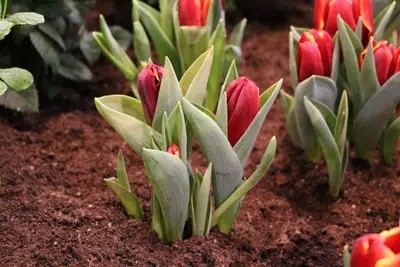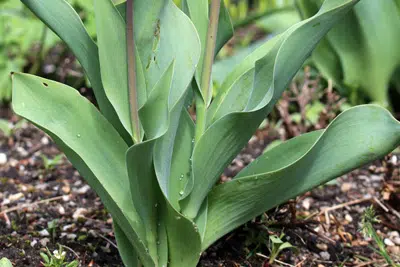The tulip (Tulipa), which belongs to the lily family, grows perennial and herbaceous and depending on the variety, with growth heights from 10 to 70 cm. There are tulips that captivate not only by their flower shape or color, but with an intense fragrance. They decorate perennial beds, rock gardens or the edge of lawns. But, what if the tulips do not bloom, what can be the reasons?
Contents
When the tulip bloom fails to appear
The tulip is one of the first harbingers of spring. With about 150 species, it is by far the largest and most varied genus among the bulbous flowers. They come in almost every flower color, the most diverse color combinations and intensely fragrant. While some feel most comfortable in the partial shade of larger woody plants, others prefer rather light locations in rock gardens but also bowls and pots. If the tulips then refuse to bloom, that hurts the gardener’s heart. If the flower fails to bloom, this can have different causes.
Causes and solutions
In the spring they are eagerly awaited and after a few weeks it is already over again with the flower splendor. If the tulip receives the right care after flowering, it will show its colorful flowers again next year. On the other hand, mistakes in care, planting, an unfavorable location, but also pests, especially voles, can quickly destroy the hope of a renewed tulip bloom next year.
Nutrient deficiency
Tulips can only form flowers if they receive sufficient nutrients. They belong to the group of highly nutritious plants and accordingly require a lot of nutrients. The larger the flowers are, the higher the nutrient requirement. A deficiency can be remedied relatively easily.
- work some compost or horn shavings into the soil already in spring
- use other organic fertilizers with high potassium and magnesium content
- generally fertilize during leaf budding, until shortly before flowering
- in addition to regular fertilization, pruning at the right time is also important
- bulbs draw nutrients from the green parts of the plant after flowering
- Leave leaves and stems until they are wilted
- If the green parts of the tulip are also cut off immediately after flowering, it loses important nutrients that it needs for a good start to the next season. Therefore, the leaves should be left until they are completely wilted.

Too much wetness
Another cause of missing blooms can be too much wetness, or a too-wet fall or winter. When too much rain can’t drain away, rot and mold can quickly develop on the tulip bulbs. This, in turn, can severely weaken the bulbs and, in the worst case, even cause them to spoil completely.
- too much moisture is a problem not only in autumn and winter
- also in summer at too wet locations
- between other plants that need a lot of water and are watered frequently
- bulbs can easily rot there
- therefore pay attention to the right location
- to avoid the danger of too much wetness, dig up bulbs
- only after they have completely yellowed or wilted
- after digging store in a shady and dry place
Tip: Small daughter bulbs, which you separate from the mother bulb and plant separately, take up to three years to bloom for the first time
Unfavorable location conditions
If tulips do not want to bloom, it is partly due to the location or the soil. These bulb flowers can stand for several years in one and the same place, provided that they are in sandy, summer-dry soil, where the bulbs can always dry well. This can be, for example, under woody plants, in front of hedges or between perennials and roses.
However, when planting new bulbs, care should be taken to choose sites where tulips have not been in previous years. The bulbs can be damaged by soil fungi, so that the flowering with the years is less and less or fails completely, the soil becomes ‘tulip tired’.
Mistakes in planting
Mistakes in planting can also cause tulips to produce leaves but no flowers. This mainly concerns the time of planting and planting depth and spacing.
- to sprout in the spring, plant hardy tulip bulbs before the first frost.
- best time in the fall, between September and mid-November.
- when the soil has already cooled slightly
- as a rule, when the outside temperatures are below ten degrees
- if bulbs are planted too deep, usually only leaves and no flowers are formed
- planting depth varies depending on the nature of the soil and the size of the bulb
- in sandy soil, to a depth of 30 cm
- in normal garden soil, between 15 and 20 cm deep
- always cover with soil twice the height of the bulb
- for planting distances about 15 cm is recommended
Tip: Even if the tulip bulb finds optimal conditions, in the year of planting it initially forms only leaves and stores the necessary reserves for flowering the next year. In order to enjoy tulip flowering every year, it is recommended to plant fresh bulbs about every two or three years between those already planted

Pests
The best location and the best care are of no use if pests, especially voles, get at the tulip bulbs. Flower bulbs are at the top of the menu of these pesky rodents. Once they have found the bulbs, it is usually not only the flower that fails to bloom. These bulbs can usually not be saved, only good prevention can help. This means that the bulbs should be planted in such a way that the rodents have no chance to get to them.
For this purpose, they can be placed in the ground in planting baskets or wire netting about 20 cm in diameter, or brushwood or cuttings can be used, for example from rose pruning. Dig a larger planting hole and line it like a nest with a dense mesh of cuttings or brushwood, both the bottom and the sides. Then fill with soil until all the gaps are closed. Then insert the tulip bulbs in the center and loosely cover them with soil. In this way, the bulbs should be well protected from vole predation.
Conclusion
Tulips are among the most beautiful and multifaceted spring bloomers. Their flowers impress with a great variety of colors and shapes. Depending on the time of planting, they bloom between late March and early May. Occasionally it also happens that despite green leaves, the flower fails to bloom. Then it is necessary to find out the causes and take appropriate countermeasures.


